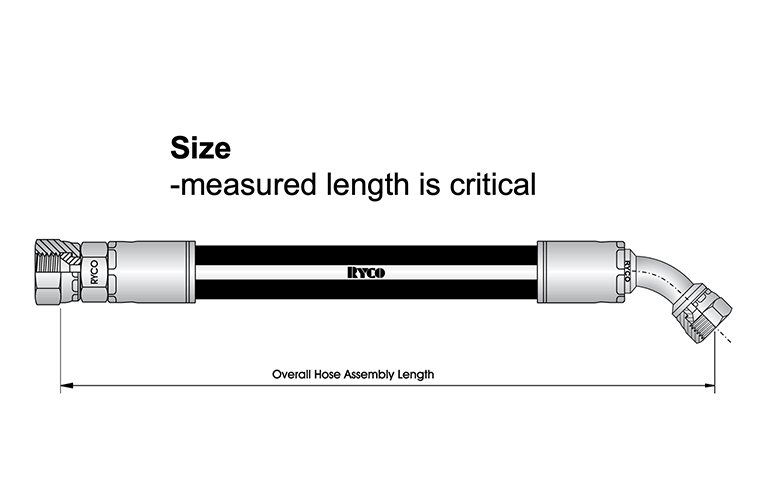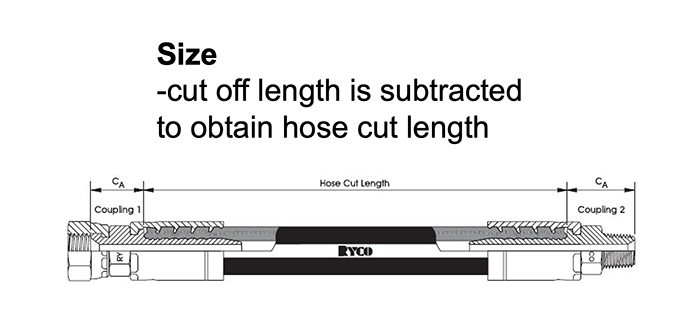Inner diameter is the bore of the hose and the size of the orifice that the fluid has to travel through over a particular length. The OD of the hose could be critical for various things like where the hose is going to fit and how strong the hose is. A very strong high-pressure hose tends to have a larger thickness as a ratio to its ID. And of course, the length will help you determine what kind of flow rates you can handle, factored in with your ID. Obviously, a smaller hose will have a higher pressure drop or an overall long length than will a larger diameter hose.
A hose must be sized appropriately to handle the flow with as little pressure drop as possible because that pressure drop is wasted just trying to move fluid through a conduit. The total amount of pressure drop should be as minimal as possible, not only for efficiency but because you want all the energy you’re putting into your prime mover to eventually do useful work at one of your actuators, whether they are a motor or cylinders.

Figure 1. Measured length is critical
Specifying the wrong length is a common mistake. You absolutely cannot use a hose that it is too short, because it won’t either fit or will break if stretched too far. If it’s too long, it could have too much slack. A hose with slack can rub, fray or cause a catastrophic failure from moving too much around the machine. These longer hoses can also sag, which creates forces on the crimp and hose interface. This can cause wear and leakages over time.
In addition, hanging and sagging hoses can get caught on something or be a tripping hazard. If a hose is only mildly too long — an inch, say — you can bolt that down to ensure safety.
Overall length is not the tip-to-tip of all the components. What really matters is measuring the interface point between the fittings on the assembly. For example, if you have a swivel JIC, you do not measure to the end of the nut, but instead, will measure to where the seat attaches to the face of the JIC interface. In the example in Figure 1, you’re measuring the male fittings. If you have your hose or tube that has a male JIC, you want to measure to the interface point on that male. This ensures accurate hose length.

Figure 2. Hose cutoff length should be subtracted to obtain hose length
This procedure is a little more difficult when you have something like a 45° or a bend fitting. With those, you must measure in the centre of the fitting because the angled interface crosses various points of the entire hose length, so the middle point is obviously the average length that the hose would expand over that period.
When making the hose assembly, you must consider the cutoff length, as seen in Figure 2. If looking at this hose assembly, you see the hose cut length. On the coupling on the left-hand side, there’s a CA dimension which is your hose cutoff length. What that means is after you have your entire hose length determined, you want to subtract the amount of space that’s taken up by the fitting itself, and that goes from the actual measured length, so you can see that it goes to the female part of the JIC.
Coupling number two is a male NPT, so that cutoff length goes right to the tip because you’re measuring to the tip of the male fittings, while the female fitting is going to be the point of interface. But those two dimensions of your overall length must be subtracted. Note, you can’t assume that they’re the same for each coupling, and you can’t average it out. You actually have to know what that is based on the catalogue information of your hose and fitting supplier.
This allows you to subtract that from the total length, and just say it’s 1 in. on one side, 1 ¼ in. on the other, so you must subtract to 2 ¼ in. from that cutoff length to get your actual total hose length.
Remember, sizing a hose assembly doesn’t just mean you measure your application and cut the hose to length. Considering the pressure drop and fitting size is critical, too. At Armadillo Group we understand hose assemblies like no one else, Exactfit pre built hose assemblies are made to fit right first time. Buy quality hose assemblies from Armadillo Group.
